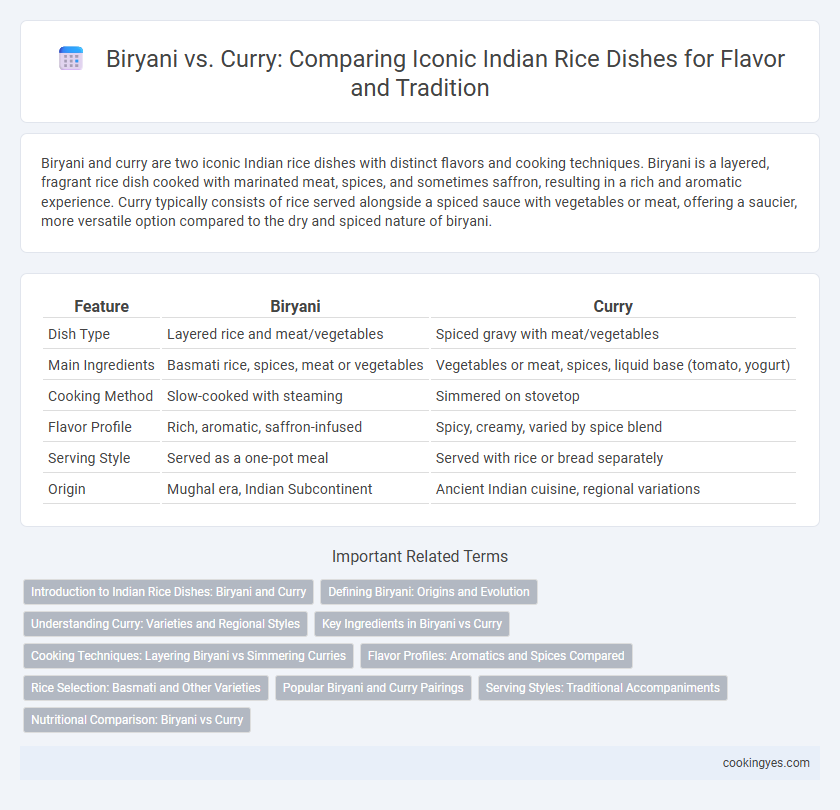Biryani and curry are two iconic Indian rice dishes with distinct flavors and cooking techniques. Biryani is a layered, fragrant rice dish cooked with marinated meat, spices, and sometimes saffron, resulting in a rich and aromatic experience. Curry typically consists of rice served alongside a spiced sauce with vegetables or meat, offering a saucier, more versatile option compared to the dry and spiced nature of biryani.
Table of Comparison
| Feature | Biryani | Curry |
|---|---|---|
| Dish Type | Layered rice and meat/vegetables | Spiced gravy with meat/vegetables |
| Main Ingredients | Basmati rice, spices, meat or vegetables | Vegetables or meat, spices, liquid base (tomato, yogurt) |
| Cooking Method | Slow-cooked with steaming | Simmered on stovetop |
| Flavor Profile | Rich, aromatic, saffron-infused | Spicy, creamy, varied by spice blend |
| Serving Style | Served as a one-pot meal | Served with rice or bread separately |
| Origin | Mughal era, Indian Subcontinent | Ancient Indian cuisine, regional variations |
Introduction to Indian Rice Dishes: Biryani and Curry
Biryani and curry represent two iconic Indian rice dishes distinguished by their cooking methods and flavor profiles. Biryani is a layered, aromatic rice dish typically cooked with marinated meat, spices, and saffron, resulting in a rich, flavorful experience. Curry involves rice served alongside a spiced gravy or sauce, offering diverse regional variations from creamy kormas to fiery vindaloos.
Defining Biryani: Origins and Evolution
Biryani, a fragrant and layered rice dish originating from Persian and Mughal culinary traditions, combines basmati rice with marinated meat or vegetables, infused with aromatic spices such as saffron, cardamom, and cloves. Its evolution in Indian cuisine reflects regional adaptations, incorporating diverse ingredients and cooking techniques to create rich, flavorful meals distinct from curry-based dishes. Unlike curry, which primarily features a spiced sauce or gravy, biryani emphasizes the harmonious melding of rice and protein through slow cooking, resulting in a dry, yet intensely spiced preparation.
Understanding Curry: Varieties and Regional Styles
Curry in Indian cuisine encompasses a diverse range of dishes characterized by rich sauces infused with spices like turmeric, cumin, coriander, and garam masala, creating distinct regional styles such as Punjabi, South Indian, and Bengali curries. Unlike biryani, which is a layered rice dish cooked with meat, vegetables, and aromatic spices, curry primarily features a spiced gravy served alongside or poured over plain rice. Understanding these varieties reveals the complexity and cultural significance of curry as a versatile staple in Indian rice dishes.
Key Ingredients in Biryani vs Curry
Biryani primarily features basmati rice layered with marinated meat or vegetables, fragrant spices like cardamom, cloves, and saffron, and often includes fried onions and fresh herbs such as mint and coriander. In contrast, curry centers around a rich, spiced gravy composed of ingredients like turmeric, cumin, coriander powder, ginger, garlic, and chili, simmered with meat, vegetables, or legumes. While biryani emphasizes aromatic rice and slow-cooking techniques to blend flavors, curry focuses on a thick, flavorful sauce that complements plain rice or bread.
Cooking Techniques: Layering Biryani vs Simmering Curries
Biryani cooking involves meticulous layering of partially cooked rice with marinated meat or vegetables, then slow-cooked using the dum method to infuse flavors deeply. Curries rely on simmering ingredients in a spiced sauce or gravy, allowing flavors to meld through prolonged heat exposure. The layering technique in biryani enhances texture contrasts, while simmering in curries prioritizes consistent flavor integration.
Flavor Profiles: Aromatics and Spices Compared
Biryani features complex layers of aromatic spices such as saffron, cardamom, cloves, and cinnamon, blended with fragrant basmati rice to create a rich, multidimensional flavor profile. Curry emphasizes a sauce-based composition with robust spice blends like turmeric, cumin, coriander, and garam masala, offering a creamy, intensely spiced taste that complements the rice. While biryani highlights fragrant rice infused with spices, curry delivers a bold, saucy experience with varied heat levels and texture contrasts.
Rice Selection: Basmati and Other Varieties
Biryani relies predominantly on long-grain Basmati rice, prized for its fragrant aroma and fluffy texture that absorbs rich spices and meat juices without becoming mushy. In contrast, curry dishes often use shorter or medium-grain rice varieties like Sona Masoori or Jasmine, which offer a softer, stickier base ideal for soaking up thick, flavorful curry sauces. The choice between Basmati and other rice types significantly impacts the overall mouthfeel and flavor balance in traditional Indian rice dishes.
Popular Biryani and Curry Pairings
Biryani and curry are iconic Indian rice dishes celebrated for their rich flavors and aromatic spices. Popular biryani varieties like Hyderabadi and Lucknowi pair exceptionally well with creamy curries such as chicken korma or rich paneer butter masala, enhancing the overall taste profile. Pairing spicy mutton or lamb biryani with cooling cucumber raita and tangy dal curry creates a balanced and fulfilling meal experience.
Serving Styles: Traditional Accompaniments
Biryani, a fragrant layered rice dish, is traditionally served with cooling raita, boiled eggs, or a simple salad to balance its rich spices. Curry rice dishes, on the other hand, are typically accompanied by naan, chapati, or other Indian breads to scoop up the thick, flavorful sauces. These serving styles highlight the contrasting textures and flavors, with biryani emphasizing aromatic rice and curry showcasing saucy, spiced gravies.
Nutritional Comparison: Biryani vs Curry
Biryani typically contains higher calories and carbohydrates due to the inclusion of basmati rice and ghee, while curry is often lower in calories but rich in protein and fiber when prepared with legumes or lean meats. Biryani's spiced rice delivers complex carbohydrates and essential micronutrients like iron and vitamin B6, whereas curry provides antioxidants and anti-inflammatory compounds from turmeric and other spices. Comparing sodium content, biryani may have higher salt levels, whereas curry's nutritional profile varies widely depending on its ingredients and preparation method.
Biryani vs Curry for Indian Rice Dishes Infographic

 cookingyes.com
cookingyes.com